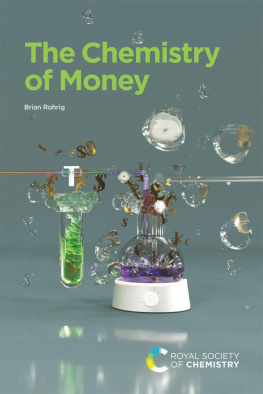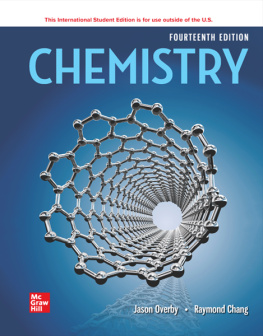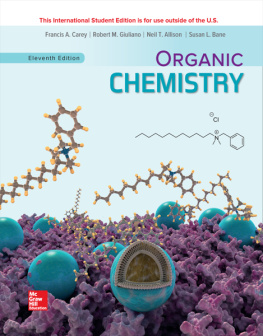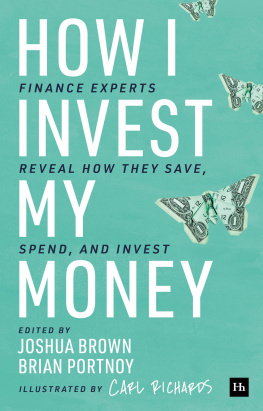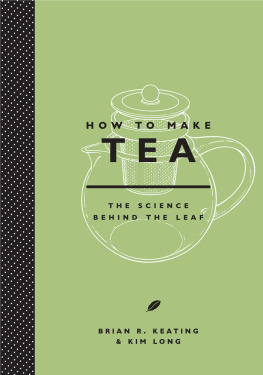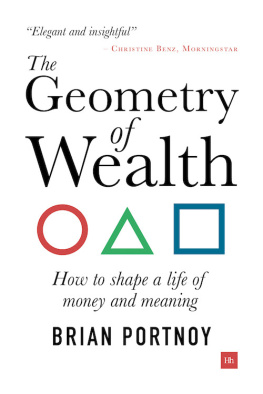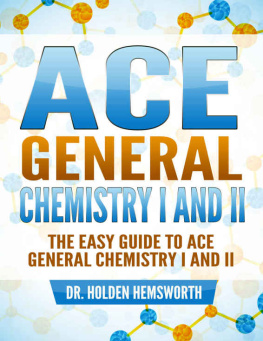Brian Rohrig - The Chemistry of Money
Here you can read online Brian Rohrig - The Chemistry of Money full text of the book (entire story) in english for free. Download pdf and epub, get meaning, cover and reviews about this ebook. year: 2020, publisher: RSC Publishing, genre: Detective and thriller. Description of the work, (preface) as well as reviews are available. Best literature library LitArk.com created for fans of good reading and offers a wide selection of genres:
Romance novel
Science fiction
Adventure
Detective
Science
History
Home and family
Prose
Art
Politics
Computer
Non-fiction
Religion
Business
Children
Humor
Choose a favorite category and find really read worthwhile books. Enjoy immersion in the world of imagination, feel the emotions of the characters or learn something new for yourself, make an fascinating discovery.
- Book:The Chemistry of Money
- Author:
- Publisher:RSC Publishing
- Genre:
- Year:2020
- Rating:5 / 5
- Favourites:Add to favourites
- Your mark:
- 100
- 1
- 2
- 3
- 4
- 5
The Chemistry of Money: summary, description and annotation
We offer to read an annotation, description, summary or preface (depends on what the author of the book "The Chemistry of Money" wrote himself). If you haven't found the necessary information about the book — write in the comments, we will try to find it.
The Chemistry of Money — read online for free the complete book (whole text) full work
Below is the text of the book, divided by pages. System saving the place of the last page read, allows you to conveniently read the book "The Chemistry of Money" online for free, without having to search again every time where you left off. Put a bookmark, and you can go to the page where you finished reading at any time.
Font size:
Interval:
Bookmark:

The Chemistry of Money
The Chemistry of Money
By
Brian Rohrig
USA
Email:

Print ISBN: 978-1-78262-983-2
EPUB ISBN: 978-1-78801-711-4
A catalogue record for this book is available from the British Library
Brian Rohrig 2021
All rights reserved
Apart from fair dealing for the purposes of research for non-commercial purposes or for private study, criticism or review, as permitted under the Copyright, Designs and Patents Act 1988 and the Copyright and Related Rights Regulations 2003, this publication may not be reproduced, stored or transmitted, in any form or by any means, without the prior permission in writing of The Royal Society of Chemistry or the copyright owner, or in the case of reproduction in accordance with the terms of licences issued by the Copyright Licensing Agency in the UK, or in accordance with the terms of the licences issued by the appropriate Reproduction Rights Organization outside the UK. Enquiries concerning reproduction outside the terms stated here should be sent to The Royal Society of Chemistry at the address printed on this page.
Whilst this material has been produced with all due care, The Royal Society of Chemistry cannot be held responsible or liable for its accuracy and completeness, nor for any consequences arising from any errors or the use of the information contained in this publication. The publication of advertisements does not constitute any endorsement by The Royal Society of Chemistry or Authors of any products advertised. The views and opinions advanced by contributors do not necessarily reflect those of The Royal Society of Chemistry which shall not be liable for any resulting loss or damage arising as a result of reliance upon this material.
The Royal Society of Chemistry is a charity, registered in England and Wales, Number 207890, and a company incorporated in England by Royal Charter (Registered No. RC000524), registered office: Burlington House, Piccadilly, London W1J 0BA, UK, Telephone: +44 (0) 20 7437 8656.
Visit our website at www.rsc.org/books
Printed in the United Kingdom by CPI Group (UK) Ltd, Croydon, CR0 4YY, UK
Preface
A rich man is nothing but a poor man with money.
W.C. Fields
When I was a kid I found $10. I still vividly remember everything about that day. I was riding my bike to a park when, lo and behold, there was a $10 bill innocently lying along the side of the road, neatly folded in half. I couldn't believe my luck! When I arrived home, I breathlessly announced to anyone within earshot my good fortune. Even though this find happened over 40 years ago, it is still so vividly etched into my memory banks that it might have occurred yesterday.
We remember momentous, life-changing eventsgetting married, the birth of a child, landing a coveted job. Experiences packed with emotion stick with us, often for a lifetime. Many combat veterans never fully recover from the severe trauma they encountered during wartime. But positive emotional experiences are just as likely to stick with us as negative onesif you score the winning goal in the championship game you will never forget it. I still remember winning a history award in school, although perhaps not as vividly as finding that $10 bill by the side of the road.
No matter how bohemian you might consider yourself to be, there is no denying the magnetic pull of money. At the Money Museum in Chicago the most popular display is a suitcase filled with one-million dollars. People gather around and stare with a kind of reverential awe at the stacks of $100 bills neatly arranged in the suitcase, 100 stacks in all. You can get your picture taken by it and receive the photo as a souvenir. In mine, I'm grinning like a Cheshire cat, thrilled to be so close to so much wealth.
In the prologue to his fine book The Power of Gold: The History of an Obsession, Peter L. Bernstein has this to say about gold, which of course has served as money throughout much of the world's history and in many ways still does today:
This book tells the story of how people have become intoxicated, obsessed, haunted, humbled, and exalted over pieces of metal called gold. Gold has motivated entire societies, torn economies to shreds, determined the fate of kings and emperors, inspired the most beautiful works of art, provoked horrible acts by one people against another, and driven men to endure hardship in the hope of finding instant wealth and annihilating uncertainty. (Excerpt reproduced from ref. with permission from John Wiley and Sons, Copyright 2001.)
Considering the incalculable toll of human misery brought on by mankind's quest for gold and all of its various incarnations, the Bible's declaration that the love of money is the root of all evil should come as no great surprise. Albert Einstein echoed these sentiments, saying, Money only appeals to selfishness and always tempts its owners irresistibly to abuse it.
Numerous thinkers have tried to shed some light on humankind's near-universal mania over money. Freud postulated that money and feces were irrevocably intertwined. He argued that the universal identification of money as dirty or filthy is no accident. In Character and Anal Erotism, Freud wrote:
We know that the gold which the devil gives his paramours turns into excrement after his departure Indeed, even according to ancient Babylonian doctrine, gold is the feces of Hell It is possible that the contrast between the most precious substance known to men and the most worthless, which they reject as waste matter (refuse), has led to this specific identification of gold with feces.
The original erotic interest in defecation is, as we know, destined to be extinguished in later years. In those years, the interest in money makes its appearance as a new interest which had been absent in childhood. This makes it easier for the earlier impulsion, which is in process of losing its aim, to be carried over to the newly emerging aim.
With the advent of functional magnetic resonance imaging (fMRI) technology in the 1990s, for the first time it was possible to look inside the brain, so to speak, in an attempt to figure out what really makes us tick. We could find out what we really thought about money, and how it might alter our brain chemistry. During magnetic resonance imaging a strong magnetic field, aided by a radio frequency pulse, causes all the hydrogen atoms within the water molecules of the body to line up in the same direction. In fMRI, changes in blood flow to particular areas of the brain can be measured with pinpoint accuracy. Oxygenated blood responds differently to a magnetic field than deoxygenated blood, providing that subtle difference that the fMRI scan can detect. So, when you read about the latest study that relates how a certain area of the brain lights up when a test subject looks at pictures of puppies, it means that fresh blood is flowing into that specific area of the brain, presumably a different area than when that same subject looks at pictures of broccoli. There are six basic emotionssurprise, anger, disgust, fear, sadness and happiness. Different regions of the brain are activated whenever one of these emotions is experienced. So, in theory, an FMRI scan can tell us what emotion we are feeling when we respond to a certain stimulus.
A plethora of studies have shown that looking at money, handling money, thinking about money and expecting to receive some money all light up certain areas of the brain like a Christmas tree. One study showed that the pain processing centers of the brain were activated when subjects taxed with spending a limited amount of money were faced with unreasonably high prices.
Font size:
Interval:
Bookmark:
Similar books «The Chemistry of Money»
Look at similar books to The Chemistry of Money. We have selected literature similar in name and meaning in the hope of providing readers with more options to find new, interesting, not yet read works.
Discussion, reviews of the book The Chemistry of Money and just readers' own opinions. Leave your comments, write what you think about the work, its meaning or the main characters. Specify what exactly you liked and what you didn't like, and why you think so.

